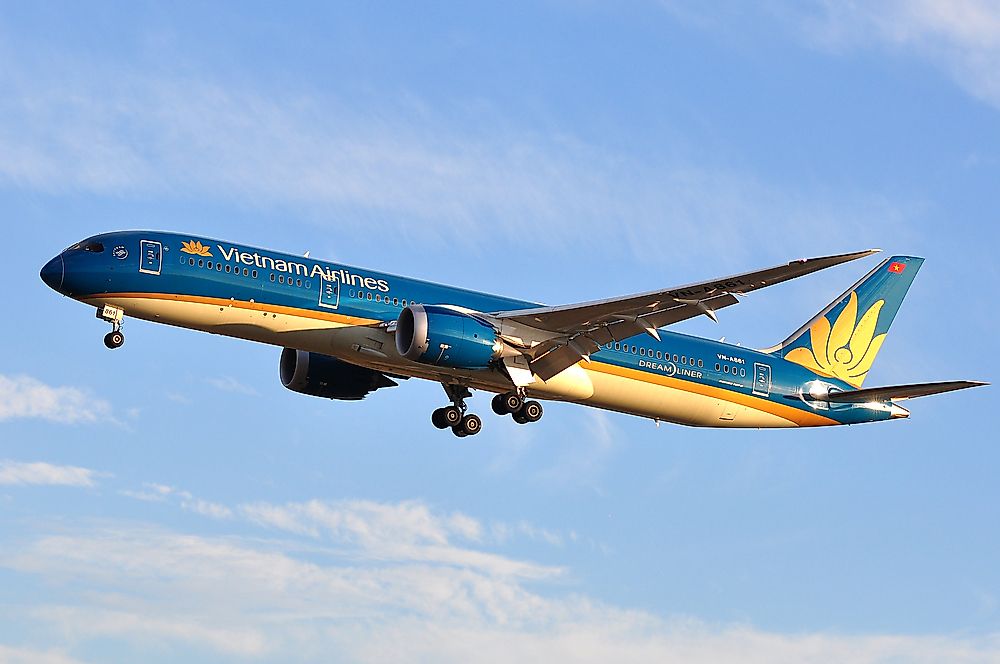What is the National Airline of Vietnam?

Vietnam Airlines is the country's flag carrier. The airline has its headquarters in Long Bien District in Hanoi, and its hubs are at Noi Bai and Tan Son Nhat International airports. Vietnam Airlines has routes covering 52 destinations in 17 countries. The carrier occupies an integral part of Vietnam's economy as it is involved in passenger transport.
History
The airline's history is traced to January 1956 when the Vietnam Civil Aviation was created by the North Vietnamese government. The airline developed until the end of the Vietnam War, and its initial international destination was Beijing and then Vientiane in 1976. The airline subsequently expanded its pool of destinations to include Bangkok, Kuala Lumpur, Hong Kong, Singapore, and Manila. It was not until 1993 that the airline was inaugurated as Vietnam's flag carrier when it became a state enterprise. The airline began phasing out its Soviet planes in 1994 when the US lifted the trade embargo instituted on the nation allowing the airline to purchase Western-made aircraft. The airline and several other aviation-related companies were incorporated to give rise to the Vietnam Airlines Corporation on May 27, 1995. Over time, the airline has expanded its fleet as well as its destinations.
Destinations
Vietnam Airlines has built a destination network in Southeast and East Asia, Europe, and Oceania. The airline operates nearly 300 flights on a daily basis, and its local destinations include Chu Lai, Da Nang, Dien Bien Phu, Dong Hoi, Haiphong, Pleiku, Quy Nhon, and Vinh. The bulk of the airline's international flights heads to Asian nations including China, Indonesia, Thailand, Japan, Cambodia, Laos, Taiwan, Myanmar, Malaysia, Taiwan, and Singapore. Other flights are destined for Germany, Russia, the UK, France, and Australia. Vietnam Airlines adds its local capacity to meet the spike in demand for local travel during the yearly Tềt celebration. The celebration falls between late January to mid-February, and it is identified as the country's most notable celebration. In 2013 for example, the airline added 174,000 extra seats during the festivity, 82,000 of which were added on the trunk route between its main hubs. The airlines began participating in SkyTeam from June 10, 2010. The carrier has made codeshare agreements with airlines like Cathay Pacific, Czech Airlines Finnair, Kenya Airways, and Qantas among others.
Fleet
The airline's fleet constitutes a total of 83 aircraft. The fleet includes 57 Airbus A321-200, 7 Airbus A350-900, 8 Airbus A330-200, and 11 Boeing 787-9. Vietnam Airlines operates an air freight branch of Vietnam Airlines Cargo through which it offers cargo services to Oceania, Europe, Asia, and North America by use of its passenger fleet as well as those of its partners. Throughout its history, the airline has used Soviet, European, and American aircraft and it currently has Airbus, ATR, and Boeing aircraft.
Future Trends
The airline aims at operating 170 aircraft by 2020, and it is implementing programs to enable it to become Southeast Asia's second-biggest full-service carrier. The airline is projected to fly to 53 destinations including African cities, Perth, Nanjing, Prague, Hangzhou, Adelaide, Mandalay, Amsterdam, Dalian, and Milan. The carrier further plans to move the bulk of its international operations to the planned Long Thanh International Airport. Vietnam Airlines also plans to boost its yearly revenue to $7 billion. There are plans to restructure the carrier and partly privatize it to facilitate better service delivery.











